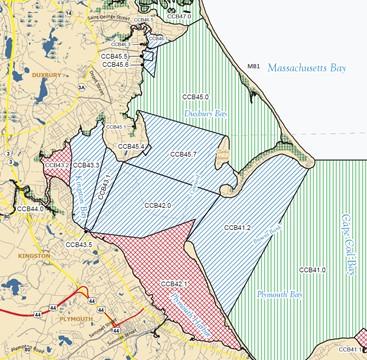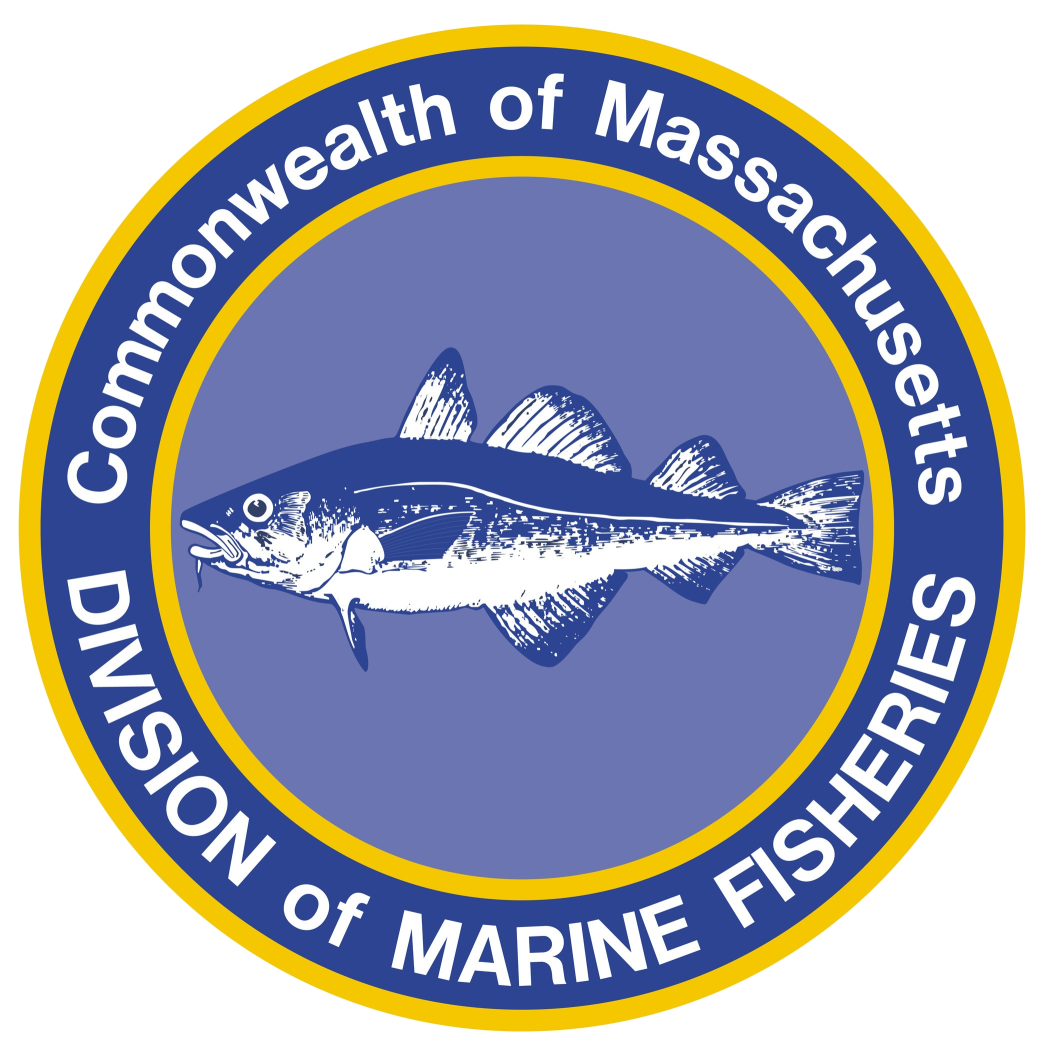- Division of Marine Fisheries

In June 2018, the U.S. Food and Drug Administration (FDA) conducted a hydrographic dye study of the Plymouth Wastewater Treatment Plant (WWTP) at the request of, and with assistance from, DMF. The purpose of the dye study was to determine the extent and impact of the WWTP on the Plymouth-Kingston-Duxbury “three-bays” system. The three bays are extremely productive shellfish areas for commercial and recreational harvesting as well as for shellfish aquaculture. Plymouth, Kingston, and Duxbury combined produce approximately $8 million in value of oyster landings annually, pre-pandemic (2018).
From June 12–15, 2018, three boat teams consisting of FDA, DMF and Plymouth personnel monitored the release of dye and tracked its movement throughout the system. Several weeks prior to the dye injection, nine shellfish cages with quahogs and oysters, along with fluorometers were deployed throughout the system. The shellfish would be tested for pathogen bioaccumulation to determine potential uptake. Dye concentration data from the fluorometers would be used to correlate effluent in marine waters originating from the Plymouth WWTP outfall. Boat work started prior to daybreak and lasted past sunset for most of the week. The following weekend, a DMF boat crew retrieved the cages.
DMF previously classified and managed Duxbury, Kingston, and Plymouth Bays waters as a combination of Approved; Conditionally Approved based on rainfall and season; and Prohibited (green, blue, and red respectively in figure below). In addition, waters inside the breakwater and shellfish areas inside Long Beach were classified/managed based on operation of the Plymouth WWTP.
After review and analysis of the dye study results, USFDA recommendations, and then conducting an evaluation of the Plymouth WWTP with the cooperation of the Town of Plymouth, the WWTP operators, and assistance of MassDEP, DMF determined the need for classification changes to waters in Plymouth Harbor, Plymouth Bay, Kingston Bay, and Duxbury Bay.
Based on dye study results indicating time of travel from the WWTP to the Duxbury Pier Light of approximately three hours, DMF determined the Prohibited Closed Safety Zone around the outfall pipe needed to be expanded. Dye study results, combined with dilution calculations, indicate that Plymouth Harbor waters north of the Closed Safety Zone including Kingston Bay, southern Duxbury Bay, and portions of Plymouth Bay may be impacted by a WWTP upset. Those calculations showed effluent excursion of 3.6 miles from the outfall during an upset. Such an upset would impact a portion of Plymouth Bay east of Long Beach and south of Saquish Neck. As such Kingston Bay, Southern Duxbury Bay, northern portions of Plymouth Harbor, and westerly portions of Plymouth Bay have been reclassified to Conditionally Approved.
The handling of product harvested from an Approved area or Conditionally Approved area based on WWTP performance, in daily practice and under average conditions with normal operations, is the same. The sanitary quality of shellfish harvested from either an Approved or Conditionally Approved area are equivalent.
The impact of these changes is significant for the growers. In the past 10+ years there has been no trade between the US and European Union for raw bivalve molluscan shellfish. A much-anticipated trade agreement is on the verge of opening molluscan trade once again. Unfortunately, as part of the agreement, only shellfish harvested from US waters classified as Approved are eligible for export to the EU. Shellfish produced and harvested by aquaculture growers in Plymouth and Kingston will be unable to take advantage of this new market. This is a significant blow to these aquaculturists and may curtail expansion of shellfish aquaculture in these communities. A reclassification from Approved to Conditionally Approved would not impact the sale of shellfish harvested from these areas within state or nationally.
Wastewater Treatment Plant Dilution Analysis Requirements
DMF is required to meet National Shellfish Sanitation Program (NSSP) requirements when classifying shellfish growing areas, particularly around WWTP outfalls. As a member of the Interstate Shellfish Sanitation Conference (a state-industry-FDA partnership), Massachusetts is committed to remaining in compliance with the NSSP. State law and regulations require that DMF follow the NSSP when classifying shellfish growing areas. The reclassifications within the three-bay system is but one necessity to remain in compliance with the NSSP and at its simplest is a sound public health measure employed by DMF at numerous plants coast-wide. Failure to comply with the NSSP could result in significant sanctions on Massachusetts’ interstate shipping of shellfish, something that must be avoided to protect our shellfish industry at large.
Establishing Closed Safety Zones and closure delineation lines is a calculation based on estimates of dilution rates as effluent dissipates in waters adjacent to a treatment plant outfall. The need to create and verify dilution analyses around wastewater treatment plants is not limited to the Plymouth facility but extends to all plants which impact shellfish growing areas in the Commonwealth as well as nation wide. Certainly, wastewater effluent transcends municipal and shellfish growing area boundaries requiring a comprehensive approach. To address this need, DMF approached the UMASS Dartmouth School for Marine Science and Technology (SMAST) specifically to conduct hydrographic modeling of DMF-identified WWTPs. To enable this cooperative effort the Massachusetts legislature increased the DMF budget appropriation in the state FY2022 budget passed this past July. This funding will allow SMAST to conduct a dilution analysis for our treatment plants coastwide. We believe these hydrodynamic modeling studies will provide the most timely and accurate depiction of WWTP effluent dilution and dispersion resulting in more precise Closed Safety Zones.
By Jeff Kennedy, Shellfish Project Manager & Greg Sawyer, Shellfish Biologist
